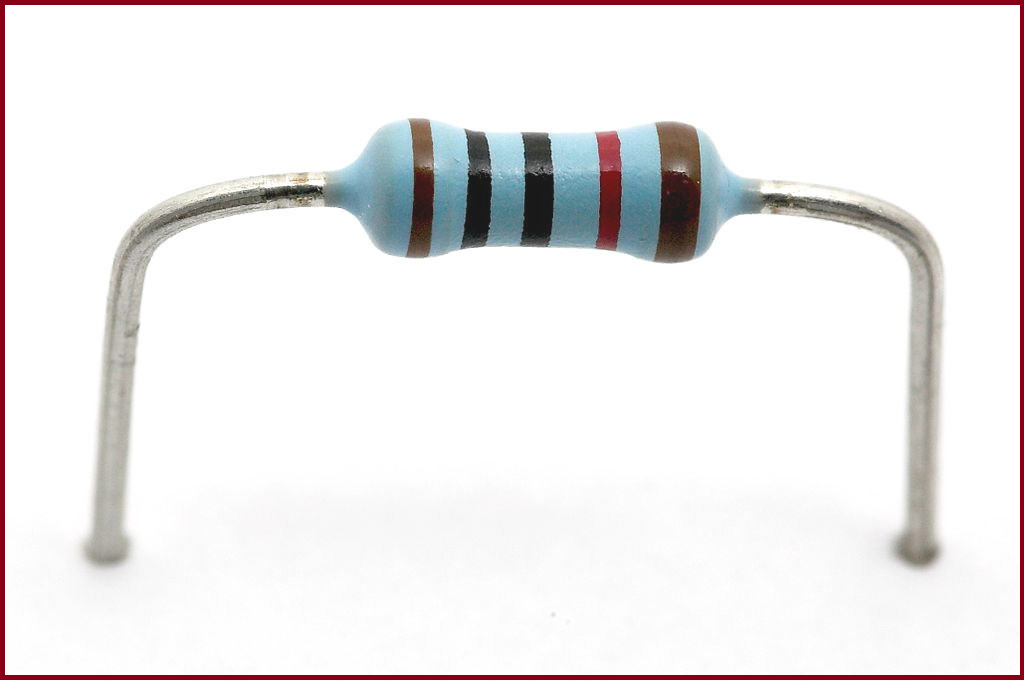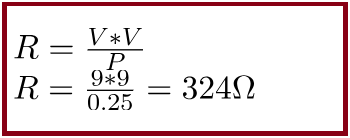Introduction
A resistor is nothing magic. Take a long wire and measure the resistance, and you will realize that resistance is just a normal property of wires (except for superconductors).

Some resistors are made up of just that. A long wire.But you can also find resistors made of other types of materials. Like this carbon film resistor:

Effect of Resistor to Circuit
The resistor is a passive device and doesn’t do anything actively to your circuit.
It’s actually a pretty boring device. If you add some voltage to it, nothing really happens. Well, maybe it gets warm, but that’s it.
BUT, by using resistors, you can design your circuit to have the currents and voltages that you want to have in your circuit.
So the resistor gives the designer control over his circuit! How about that?
How to Work With Resistors
At the beginning of my electronics career, I thought it seemed like resistor were just randomly placed around a circuit and I thought that you didn’t really need them.

For example, I remember seeing a circuit with a 9V battery, a resistor, and an LED. Then I tried using only the battery and the LED, and it still worked!
But after a few seconds, the LED turned really hot. So hot I almost burned my fingers. Then I started to realize that maybe there was something to these resistors.
Series Circuits
Current in Circuits Connected in Series
The current in a series circuit is equal everywhere in the path. The same amount of current flows through all the components. To find the current use Ohm’s law

Resistance in Series Circuits
If you have several resistors connected in series, it’s very easy to find the total resistance. All you have to do is to find the sum of all the resistance values.

Rtotal=R1+R2+R3
Current in Parallel Circuits
The current in parallel circuits can be different from path to path. To find the current of a path, you use Ohm’s law.

Calculating Resistors in Parallel

To calculate the resistance in a parallel circuit, you use the following formula

To find RTOTAL you need to invert both sides, and you’ll end up with this:

Is the current lower after a resistor?
Nooooo!It is not.It’s a common misunderstanding.But let me make it clear:
The current after a resistor is the exact same as it was before the resistor.

A circuit always has a bit of resistance, no matter if it has resistors or not in it.
Even wires have a little bit of resistance.
So let’s imagine a circuit – any kind of circuit – and say that its current is 1 ampere.
If you now add a resistor in series into this circuit – the current of the circuit will be smaller than it was.
So yes, the resistor does reduce the current.
(But the current flowing into the resistor is still the same as the current flowing out.)
This is one of the mindset shifts a beginner has to go through when learning electronics.
But after a few examples and a bit of practice, this becomes obvious. And it becomes much easier to understand what all the circuits actually do.
How To Choose A Pull-up Resistor Value

You can use resistors for many things. In the following 555 timer circuit that was referring to, the resistor R2 is a pull-up resistor with a value of 10 kΩ:

The 10k resistor (R2) is there to make sure the voltage on the pin is held at a stable high level.
“High” as in a value close to the supply voltage.
The reason that I chose the value 10k is that from my experience I know that 10k to 100k pull-up resistors usually work fine in almost all circuits.
I’ve seen this used many times and I’ve tried it myself many times.
But if you don’t know this and you need to find a value, read on.
Choosing a Pull-up Resistor Value
There are two basic guidelines for choosing a pull-up resistor value.You need a value that is:
- Not too small
- Not too big
Not Too Small
The first factor is to have a value that is not too small.
If the value is too small a lot of current will flow through the resistor, which makes it really warm and could break it.

What is “too small”?
Standard resistors often have a power rating of 0.25W (Watt).
If you look at a worst-case scenario, all the 9V of the voltage source would drop across the resistor.
Power dissipation in a resistor can be calculated with this formula:

We can solve that for R to find the minimum resistance value you need:

With a resistor of 324 Ω you’ll be at the limit of what the resistor can handle if there is a 9V drop over it.
So you want to have a value much higher than this.
If you choose a value of minimum 10-20 times this, you should be fine. For example 5 kΩ as a minimum.
Not too big
The resistor value cannot be too big.
If the resistor value is too big, you get too much voltage drop over it so that the value on the input pin is no longer high enough to be called high.
What is “too big”?
You can use this rule of thumb:
Choose a pull-up resistor value that is at least 10 times smaller than the input impedance of the pin.
(This is because the input impedance and the pull-up resistor will make up a voltage divider. Keeping it 10 times lower assures the drop across the resistor is less than 10%.)
The input impedance of the 555 timer is 10 Megaohms according to electronicsclub And 10 times smaller is 1 MΩ.
That gives you the choice of a pull-up resistor value of anywhere in between 5 kΩ and 1 MΩ.
So as you can see, you can use a range of values here.
Resistor Color Code Calculator (4 and 5-band)
The resistor color code (color bands) on your resistor tells you what value the resistor has. There are usually 4 or 5 bands.
Resistor Color Codes Table
You can find the color bands and the values they represent in the table below:

How To Use The Resistor Color Codes Table
In the resistor color codes table, you have digits, a multiplier, and a tolerance.
The multiplier tells you what you need to multiply your digits with to get the value. The tolerance tells you how accurate this value is.
If your resistor has four color bands:
- The first two bands give you the digits
- The third band gives you the multiplier
- The fourth band gives you the tolerance
If your resistor has five bands instead of four, the first three bands give you the digits. And the following two give you the multiplier and the tolerance.
Example #1

This resistor has four bands. The colors of the bands are yellow – purple – orange – gold.
From the table above we find that this means:
- Digit 4
- Digit 7
- Multiplier 1000
- Tolerance 5%
47 multiplied by 1000 is 47000.
So this is a resistor with 47000 Ω (47 kΩ).
A tolerance of 5% means that the real value could be 5% higher or lower than 47 kΩ.
Example #2

This resistor has five bands. The colors of the bands are orange – green – black – red – brown.
From the table above we find that this means:
- Digit: 3
- Digit: 5
- Digit: 0
- Multiplier: 100
- Tolerance: 1%
350 multiplied by 100 is 35000.
So this is a resistor with 35000 Ω (35 kΩ).
A tolerance of 1% means that the real value could be 1% higher or lower than 35 kΩ.
Types of Resistors and How To Choose One

Your electronic schematic tells you that you need a resistor of 100k Ohms. Ok, so you go to an online store to buy one. But there you get all these choices: Thin film, carbon composition, metal film +++.
“Just give me a freaking 100k resistor man!”, you scream in despair.
Believe me, I know your frustration. It took me a long time to actually bother reading about different types of resistors. So I just chose random resistors for all my electronic circuits. Usually, it worked flawlessly. Maybe I was lucky or maybe I just didn’t identify the resistor as the problem when I had a problem.
Anyway, my aim here is to provide a simple guide on how to choose a resistor without diving deep into details.
Resistor types
Resistors can be made of several different materials and methods. Here are a few types of resistors:

- Carbon composition
- Carbon film
- Metal film
- Thick and thin film
- Foil resistor
- Wirewound
The different types have different properties. Some are very accurate, some can withstand high temperatures, some can withstand high power and some are cheap. Some are good for low noise applications, some are good for high-power applications, some for high-speed applications and some for measurement circuits.
Choosing a resistor
So, how do you choose a resistor?
First of all, you need to choose the resistance value. To do that you use Ohm’s law. One common example is to find the resistor value you need for an LED.
Next, you need to consider the power that the resistor needs to dissipate. Power dissipation in a resistor can be calculated with the formula

where P is power in Watt, V is the voltage drop over the resistor and R is the resistance of the resistor in Ohm.
Let us look at an example:

In this circuit, we use a LED with a voltage drop of about 2V. We found that the resistor should have a value of 350 Ohm. The circuit is powered by a 9V battery.
How much power will dissipate in the resistor?
To answer this, we first find the voltage drop over the resistor. Let’s say we use a LED with a voltage drop of 2V. That means the voltage drop over the resistor will be 9V-2V = 7V.
Using the formula for power dissipation, we find P = 7V*7V / 350 Ohm = 0.14 W.
So we need a resistor with a power rating of at least 140 mW. But preferably more.
A rule of thumb is to find a resistor with twice the power rating. Here I would choose a 250 mW resistor since those are the most standard ones.
Usually, you can just use the cheapest resistor you can find with the correct power rating.
When to choose a non-standard resistor?

So why all these different types of resistors that I mentioned before? Because for some circuits the actual type of resistor also matters. These circuits include:
- Noise-sensitive audio circuits
- RF circuits
- High-power circuits
- High-accuracy measurement circuits
- High-speed circuits

Leave a comment